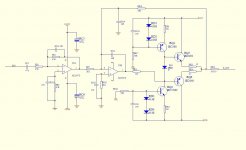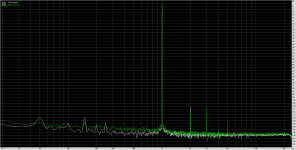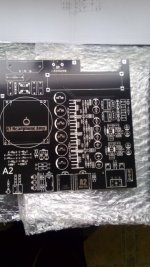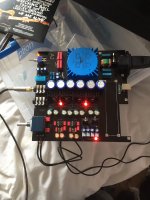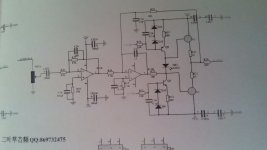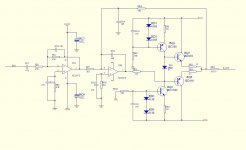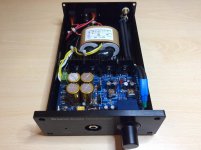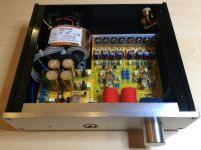Hi, i'm searching some info about rolling opamps in A1 clone gold and this seems the best place to ask about.
I have replaced the stock opamp with a BB2132, at home i also have BB2107 and a TLE2062CP, should i try this opamps?
And, sorry but my electronic background is poor, what are the characteristic that i have to consider on rolling opamp for the best match with A1 amp?
Thank you
I have replaced the stock opamp with a BB2132, at home i also have BB2107 and a TLE2062CP, should i try this opamps?
And, sorry but my electronic background is poor, what are the characteristic that i have to consider on rolling opamp for the best match with A1 amp?
Thank you
DK90,
I have done extensive listening test with multiple opamps in my A1 clone (including OPA1641, OPA2209, LME49720HA, OPA211, OPA2604, OPA2134, ADA4627) and had the best results with:
1. LT1057 (very refined sound, my personal favorite in combination with Beyer T90)
2. OPA827 (Very detailed and spacious sound)
3. OPA602BP (Detailed, warm sound)
... all gave a massive improvement over the stock ST MC33078.
(btw OPA604, LME49990 and OPA1612 are unstable in the A1)
Regards,
Louis
I have done extensive listening test with multiple opamps in my A1 clone (including OPA1641, OPA2209, LME49720HA, OPA211, OPA2604, OPA2134, ADA4627) and had the best results with:
1. LT1057 (very refined sound, my personal favorite in combination with Beyer T90)
2. OPA827 (Very detailed and spacious sound)
3. OPA602BP (Detailed, warm sound)
... all gave a massive improvement over the stock ST MC33078.
(btw OPA604, LME49990 and OPA1612 are unstable in the A1)
Regards,
Louis
DK90,
I have done extensive listening test with multiple opamps in my A1 clone (including OPA1641, OPA2209, LME49720HA, OPA211, OPA2604, OPA2134, ADA4627) and had the best results with:
1. LT1057 (very refined sound, my personal favorite in combination with Beyer T90)
2. OPA827 (Very detailed and spacious sound)
3. OPA602BP (Detailed, warm sound)
... all gave a massive improvement over the stock ST MC33078.
(btw OPA604, LME49990 and OPA1612 are unstable in the A1)
Regards,
Louis
Thankyou for your suggestions Louis. I've tried the LT1057 on my A1 clone (FA1-PRO) and results were phenomenal. Bass returned to bearable levels and the pronounced mid hump was reduced. Great detail, very low noise and great soundstage. Tested on Beyerdynamic T1 and Audio Technica M50.
A definite must for all FA1-PRO owners.
I found this schematic for such a clone but don't know how accurate it is.
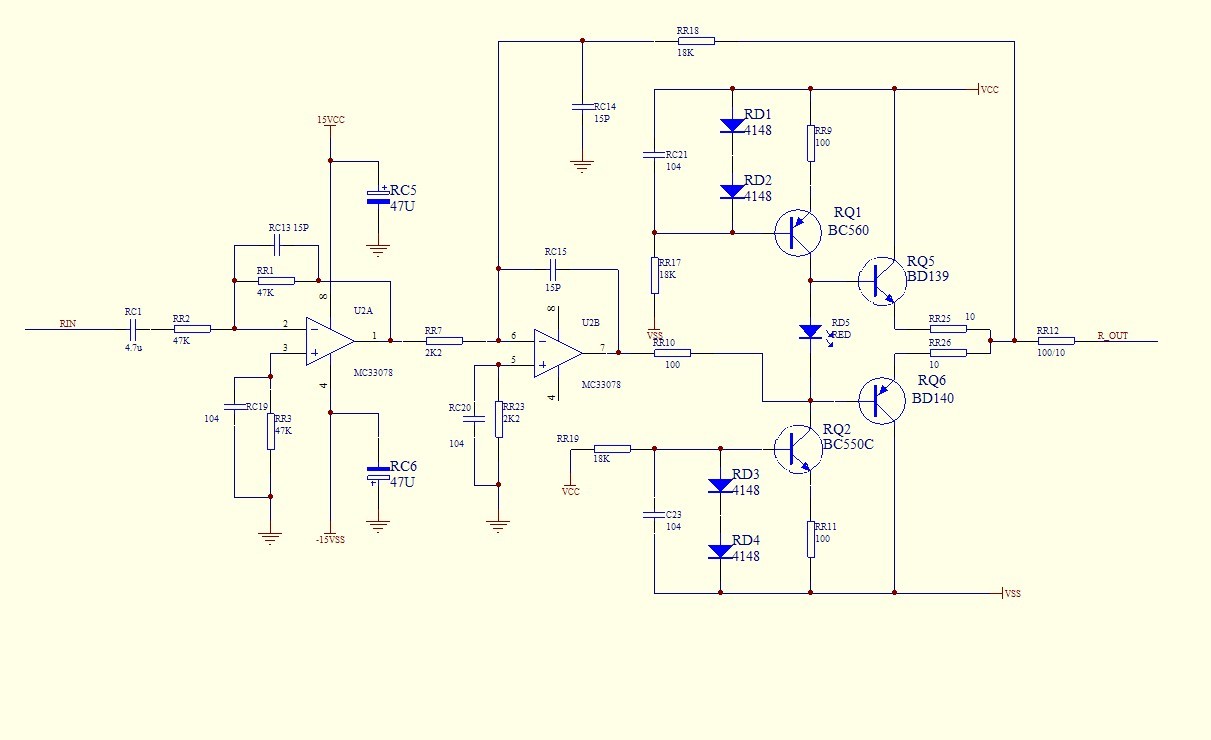
My thoughts:
1. A bit noisy, that one. Swapping RR1-3 for 22k should help somewhat. Alternatively, you could rewire that stage as a unity-gain follower, with all the usual caveats (common-mode / input impedance distortion needs to be watched).
2. With all the noise from the previous stage, RC20 is rather pointless. It may be more useful in parallel to the red LED, though there I'd prefer more like 22-100 µF.
3. Looks like the Beyer folks weren't as smart as I thought they'd be, not exploiting Class A biasing for U2B (which would have been a good idea given the very low output stage bias found in the stock MC33078). All you'd have to do is remove RQ2, the BC550C.
4. I don't know what's up with RC14, I suppose it's used to set an opamp gain of ~2 at RF in conjunction with RC15. Note that RC15 would have to be increased in value if gain were reduced (~18 dB, stock).
5. This seems like the kind of circuit that a boring old NE5532 or OPA2132/4 would do well in, past item (1.) that is.
My thoughts:
1. A bit noisy, that one. Swapping RR1-3 for 22k should help somewhat. Alternatively, you could rewire that stage as a unity-gain follower, with all the usual caveats (common-mode / input impedance distortion needs to be watched).
2. With all the noise from the previous stage, RC20 is rather pointless. It may be more useful in parallel to the red LED, though there I'd prefer more like 22-100 µF.
3. Looks like the Beyer folks weren't as smart as I thought they'd be, not exploiting Class A biasing for U2B (which would have been a good idea given the very low output stage bias found in the stock MC33078). All you'd have to do is remove RQ2, the BC550C.
4. I don't know what's up with RC14, I suppose it's used to set an opamp gain of ~2 at RF in conjunction with RC15. Note that RC15 would have to be increased in value if gain were reduced (~18 dB, stock).
5. This seems like the kind of circuit that a boring old NE5532 or OPA2132/4 would do well in, past item (1.) that is.
Attachments
If you like LT1057 you will be even more impressed with the muses8820. Personally I like it even more than the muses02.Thankyou for your suggestions Louis. I've tried the LT1057 on my A1 clone (FA1-PRO) and results were phenomenal. Bass returned to bearable levels and the pronounced mid hump was reduced. Great detail, very low noise and great soundstage. Tested on Beyerdynamic T1 and Audio Technica M50.
A definite must for all FA1-PRO owners.
Is very synergetic with the beyerdynamics T90.
Advice Pls
I have the Beyerdynamic A20 clone and was just wondering if any of the op amps would work in it.
Not a good build by the way schematic was wrong and pcb print had random numbers and values on it. Only completed with the help of Gradobob on RockGrotto forum
Martin
DK90,
I have done extensive listening test with multiple opamps in my A1 clone (including OPA1641, OPA2209, LME49720HA, OPA211, OPA2604, OPA2134, ADA4627) and had the best results with:
1. LT1057 (very refined sound, my personal favorite in combination with Beyer T90)
2. OPA827 (Very detailed and spacious sound)
3. OPA602BP (Detailed, warm sound)
... all gave a massive improvement over the stock ST MC33078.
(btw OPA604, LME49990 and OPA1612 are unstable in the A1)
Regards,
Louis
I have the Beyerdynamic A20 clone and was just wondering if any of the op amps would work in it.
Not a good build by the way schematic was wrong and pcb print had random numbers and values on it. Only completed with the help of Gradobob on RockGrotto forum
Martin
For a while there were some great discrete headphone amps on eBay, haven't looked lately though, never understood the op amp ones when you could get the other for the same cost.
There are some reasonable discrete op amps from Korea that are not bad at all, maybe that could be the way to go?
The 200r in series with the output can't be that great for the sound/damping factor, is it really needed?
There are some reasonable discrete op amps from Korea that are not bad at all, maybe that could be the way to go?
The 200r in series with the output can't be that great for the sound/damping factor, is it really needed?
Hi Martin,
I see a lot of similarity between the A2 and A1 in both the pcb lay-out and the schematics.
I have included pictures of the A1 schematic and both of the A1 clones that I have built myself.
As the mc33078 is a bipolar opamp I would suggest you give the muses8820 a try.
It is not too expensive and they are my favorite in both of my A1 clones. (Profusion plc is one of the trusted sources if you would like to buy them)
regards, Louis
I see a lot of similarity between the A2 and A1 in both the pcb lay-out and the schematics.
I have included pictures of the A1 schematic and both of the A1 clones that I have built myself.
As the mc33078 is a bipolar opamp I would suggest you give the muses8820 a try.
It is not too expensive and they are my favorite in both of my A1 clones. (Profusion plc is one of the trusted sources if you would like to buy them)
regards, Louis
Attachments
Hi Louis,
Thanks for the information it's a great help.
I had begun to think that about the A2 (an A1 but with two phone sockets) but don't have the tech knowledge to verify it.
I'll try those 8820s at the price from your supplier they seem a viable option. I have been unable to find any under £10 each and only smd.
I'll put that firm on my bookmarks, I've not come across them before.
All the best
Martin
Thanks for the information it's a great help.
I had begun to think that about the A2 (an A1 but with two phone sockets) but don't have the tech knowledge to verify it.
I'll try those 8820s at the price from your supplier they seem a viable option. I have been unable to find any under £10 each and only smd.
I'll put that firm on my bookmarks, I've not come across them before.
All the best
Martin
TBH I'd rather be looking at either a low-Ib bipolar input job (e.g. NJM4556AD, maybe NJM4565D) or a FET input part (e.g. OPA2132/4, AD712) instead. This circuit is all inverting, with the first stage having some rather high impedance to contend with, so low current noise is important while common-mode issues don't matter. I'd assume a MUSES8820 to have current noise similar to the stock MC33078.
Actually the three 47k resistors in the first (inverter) stage are quite high in value indeed, needlessly degrading noise performance - what value is the volume pot? You could easily go down to Rpot/2 (so e.g. 22k for a 50k), and even Rpot/4 still wouldn't be that bad, only warping the pot characteristic a bit. Going from 47k to 10k would drop noise levels by almost 9 dB with the stock MC33078s, these are operated well outside their noise sweetspot.
Around 100-220 µF in parallel to the bias LED would come in handy - observe polarity.
Having equal currents sourced and sunk seems like a missed opportunity for some opamp Class A biasing, but anyway.
Actually the three 47k resistors in the first (inverter) stage are quite high in value indeed, needlessly degrading noise performance - what value is the volume pot? You could easily go down to Rpot/2 (so e.g. 22k for a 50k), and even Rpot/4 still wouldn't be that bad, only warping the pot characteristic a bit. Going from 47k to 10k would drop noise levels by almost 9 dB with the stock MC33078s, these are operated well outside their noise sweetspot.
Around 100-220 µF in parallel to the bias LED would come in handy - observe polarity.
Having equal currents sourced and sunk seems like a missed opportunity for some opamp Class A biasing, but anyway.
Last edited:
Hi Sgrossklass,
Thanks for your thoughts.
The pot is 50k. The opa 2134 was on my list but wasn't sure it would be stable in the circuit. Will try the NJM4556/4565 later
Not knowledgable enough or have the equipment to test theses ops incicuit.
Only use a DMM and a peak analyser to sort out polarities/orientation and values of the components.
Unfortunately no room for the100 - 200uF cap on the leds
Regards
Martin
Thanks for your thoughts.
The pot is 50k. The opa 2134 was on my list but wasn't sure it would be stable in the circuit. Will try the NJM4556/4565 later
Not knowledgable enough or have the equipment to test theses ops incicuit.
Only use a DMM and a peak analyser to sort out polarities/orientation and values of the components.
Unfortunately no room for the100 - 200uF cap on the leds
Regards
Martin
Assuming they are actually following the stock schematic posted earlier, definitely not. Among the high-impedance inverting input stage and substantial gain, you'd be looking at an estimated >50 µV worth of output noise (SNR <60 dB ref.: 50 mV, where the best amplifiers available are somewhere around 90 dB). This kind of design is basically the antithesis of low noise. You could improve matters by up to 20 dB or so by using lower gain and accepting lower input impedance.Are these good enough noise-floor wise for high-efficiency headphones like IEMs?
If you want a DIY design for this kind of application, an O2 equipped for gains of 1X/2.5X would be a much better bet.
Last edited:
- Home
- Amplifiers
- Headphone Systems
- Beyerdynamic A1 clone gold, opamp rolling
